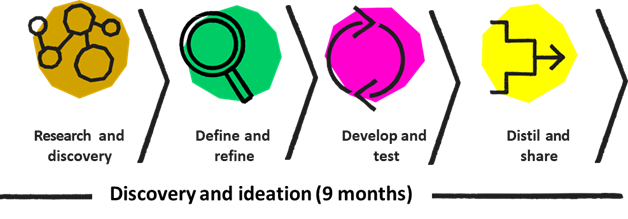What is the Lab?
The Q Lab is an innovation lab tackling complex problems in health and care services. Our labs support participants to creatively design solutions, enabling them to experiment and learn in a safe space, and giving them the skills to implement ideas in practice. Through the Lab we provide grant funding for a small number of teams to work through, test and implement their ideas in practice.
Collaboration is the foundation of the Q Lab. We use different creative and collaborative tools and techniques to support test teams to solve these complex problems. In our most recent Lab we brought four teams (test teams) together to explore and test how we can create collective responsibility to reduce waits for elective care.
As part of the Lab, the test teams used different tools and methods, and many of these can be found in our Creative Approaches to Problem Solving (CAPS) toolkit. These tools support them to research, refine, test and share their interventions to tackle these complex problems.

Stakeholder and journey maps are two of the key tools we use during the most recent Lab to visualise pathways. They are a method for building relationships across the pathways the Lab test teams operate within. This piece focuses on these two methods.
Stakeholder maps
Stakeholder maps help us see all the people that are part of the ecosystem we operate in. They provide insights about the people who influence our work. It’s important for the test teams to create these maps as a starting point to see everyone involved in their pathways and how these relationships could impact their projects.
Stakeholder mapping is helpful. Because you know in your head who they [stakeholders] are, or you think you do. It’s only when you start to put them in that you think, “Oh, and so and so, and other people…”
The first step in the stakeholder mapping process was to list out all stakeholders the test teams interacted with along their pathway. This exercise allowed the teams to go broad with their thinking and include everyone from the wider health system to their core teams.
Then, the test teams used a mapping grid to categorise their stakeholders across potential levels of interest and influence. Seeing that each stakeholder group had varying degrees of interest and influence, helped the teams to tailor their messaging.
Most importantly, the test teams understood that stakeholder mapping was not a one-time, standalone exercise but rather a dynamic tool that needed to be revisited throughout the course of their project.
People change. Because people’s jobs change, because processes change, revisiting that, and not assuming that this looks the same throughout the whole time, just as it has been so far. … revisiting the stakeholder map wasn’t a scheduled thing. It was when it felt like things had changed too much and they were starting to become out of control again. So it was a feeling rather than a diarised thing.
Journey maps
Journey maps, on the other hand, help us understand the interactions a person/user has with the service. According to IDEO, ‘it is an important starting point because it allows you to think through the human, physical, and digital interactions that are happening over time.’ They allow us see the pathway and stakeholders involved, understand how the stakeholders feel about the currently available services, and the parts of the service that may need improvement.
It was important for the lab test teams to understand the different stakeholder journeys, particularly service user/patient journeys. This allowed them to empathise with these stakeholders and begin to think through solutions that were not only efficient for the system, but better for the user.
“When you’re mapping a process or a pathway, there’s a tendency to often focus on the negative, because you’re looking to introduce some kind of change. But it’s important to highlight the positives within them, to identify opportunities where you can, potentially, utilise resources better and you can get quick wins.”
The first step in creating a user journey map is to break down the pathways into manageable/more generic/smaller domains. This could be as simple as ‘Before service, during service and after service.’
The latest Lab topic focused on clinical pathways. For some teams, this looked like ‘intake, admission, release.[JM1] ’ The teams broke down each user interaction to build their maps. For example a call from the patient to the secretary to book an appointment, or the transfer of x-rays from the radiologist to the primary care physician.
These maps captured details like:
- Interactions across the pathway
- Where interactions occurred
- The time interactions took
- The patients feelings during the interactions.
Most teams acknowledged that creating a visual journey map was useful because it allowed them see duplications within their pathway that could be resolved immediately.
We literally took a roll of paper [and] post-it notes, mapped it all out, and the amount of times the admin processes were duplicated/triplicated… We took something that was five metres long and reduced it to a metre, by just cutting out all the admin processes that were duplicated.
Conclusion
The stakeholder and journey maps, while individually useful, complemented one another in the way they were used by the Lab teams. Completing these maps allowed test teams to see who was involved in their pathway from end-to-end without constraints. The journey map then served as an additional layer to visualise the roles the stakeholders played along their pathways. For some of our teams, the journey map helped them empathise with their patients, which is a very important component of addressing complex health challenges.
We hope this provides some inspiration to think about how you can use these methods to help with your work. To get the most out of these tools, use them early in your project, and revisit them regularly as your work progresses.
To learn more about the methods we explore during the Lab, get in touch with the Lab team: Qlab@health.org.uk